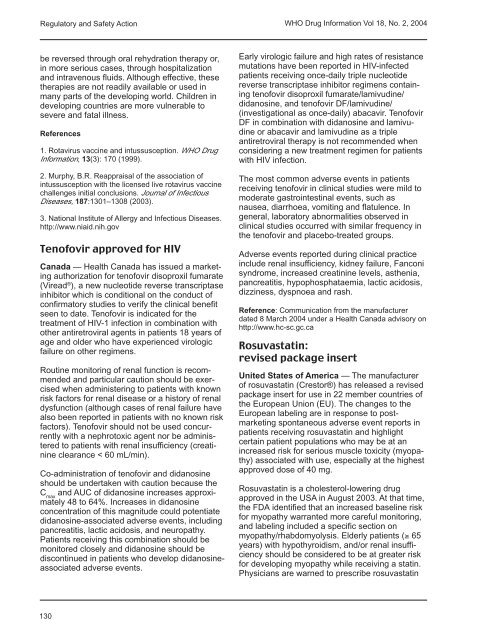WHO Drug Information Vol. 18, No. 2, 2004 - World Health ...
WHO Drug Information Vol. 18, No. 2, 2004 - World Health ...
WHO Drug Information Vol. 18, No. 2, 2004 - World Health ...
You also want an ePaper? Increase the reach of your titles
YUMPU automatically turns print PDFs into web optimized ePapers that Google loves.
Regulatory and Safety Action<br />
be reversed through oral rehydration therapy or,<br />
in more serious cases, through hospitalization<br />
and intravenous fluids. Although effective, these<br />
therapies are not readily available or used in<br />
many parts of the developing world. Children in<br />
developing countries are more vulnerable to<br />
severe and fatal illness.<br />
References<br />
1. Rotavirus vaccine and intussusception. <strong>WHO</strong> <strong>Drug</strong><br />
<strong>Information</strong>, 13(3): 170 (1999).<br />
2. Murphy, B.R. Reappraisal of the association of<br />
intussusception with the licensed live rotavirus vaccine<br />
challenges initial conclusions. Journal of Infectious<br />
Diseases, <strong>18</strong>7:1301–1308 (2003).<br />
3. National Institute of Allergy and Infectious Diseases.<br />
http://www.niaid.nih.gov<br />
Tenofovir approved for HIV<br />
Canada — <strong>Health</strong> Canada has issued a marketing<br />
authorization for tenofovir disoproxil fumarate<br />
(Viread ® ), a new nucleotide reverse transcriptase<br />
inhibitor which is conditional on the conduct of<br />
confirmatory studies to verify the clinical benefit<br />
seen to date. Tenofovir is indicated for the<br />
treatment of HIV-1 infection in combination with<br />
other antiretroviral agents in patients <strong>18</strong> years of<br />
age and older who have experienced virologic<br />
failure on other regimens.<br />
Routine monitoring of renal function is recommended<br />
and particular caution should be exercised<br />
when administering to patients with known<br />
risk factors for renal disease or a history of renal<br />
dysfunction (although cases of renal failure have<br />
also been reported in patients with no known risk<br />
factors). Tenofovir should not be used concurrently<br />
with a nephrotoxic agent nor be administered<br />
to patients with renal insufficiency (creatinine<br />
clearance < 60 mL/min).<br />
Co-administration of tenofovir and didanosine<br />
should be undertaken with caution because the<br />
C max and AUC of didanosine increases approximately<br />
48 to 64%. Increases in didanosine<br />
concentration of this magnitude could potentiate<br />
didanosine-associated adverse events, including<br />
pancreatitis, lactic acidosis, and neuropathy.<br />
Patients receiving this combination should be<br />
monitored closely and didanosine should be<br />
discontinued in patients who develop didanosineassociated<br />
adverse events.<br />
130<br />
<strong>WHO</strong> <strong>Drug</strong> <strong>Information</strong> <strong>Vol</strong> <strong>18</strong>, <strong>No</strong>. 2, <strong>2004</strong><br />
Early virologic failure and high rates of resistance<br />
mutations have been reported in HIV-infected<br />
patients receiving once-daily triple nucleotide<br />
reverse transcriptase inhibitor regimens containing<br />
tenofovir disoproxil fumarate/lamivudine/<br />
didanosine, and tenofovir DF/lamivudine/<br />
(investigational as once-daily) abacavir. Tenofovir<br />
DF in combination with didanosine and lamivudine<br />
or abacavir and lamivudine as a triple<br />
antiretroviral therapy is not recommended when<br />
considering a new treatment regimen for patients<br />
with HIV infection.<br />
The most common adverse events in patients<br />
receiving tenofovir in clinical studies were mild to<br />
moderate gastrointestinal events, such as<br />
nausea, diarrhoea, vomiting and flatulence. In<br />
general, laboratory abnormalities observed in<br />
clinical studies occurred with similar frequency in<br />
the tenofovir and placebo-treated groups.<br />
Adverse events reported during clinical practice<br />
include renal insufficiency, kidney failure, Fanconi<br />
syndrome, increased creatinine levels, asthenia,<br />
pancreatitis, hypophosphataemia, lactic acidosis,<br />
dizziness, dyspnoea and rash.<br />
Reference: Communication from the manufacturer<br />
dated 8 March <strong>2004</strong> under a <strong>Health</strong> Canada advisory on<br />
http://www.hc-sc.gc.ca<br />
Rosuvastatin:<br />
revised package insert<br />
United States of America — The manufacturer<br />
of rosuvastatin (Crestor®) has released a revised<br />
package insert for use in 22 member countries of<br />
the European Union (EU). The changes to the<br />
European labeling are in response to postmarketing<br />
spontaneous adverse event reports in<br />
patients receiving rosuvastatin and highlight<br />
certain patient populations who may be at an<br />
increased risk for serious muscle toxicity (myopathy)<br />
associated with use, especially at the highest<br />
approved dose of 40 mg.<br />
Rosuvastatin is a cholesterol-lowering drug<br />
approved in the USA in August 2003. At that time,<br />
the FDA identified that an increased baseline risk<br />
for myopathy warranted more careful monitoring,<br />
and labeling included a specific section on<br />
myopathy/rhabdomyolysis. Elderly patients (≥ 65<br />
years) with hypothyroidism, and/or renal insufficiency<br />
should be considered to be at greater risk<br />
for developing myopathy while receiving a statin.<br />
Physicians are warned to prescribe rosuvastatin

















